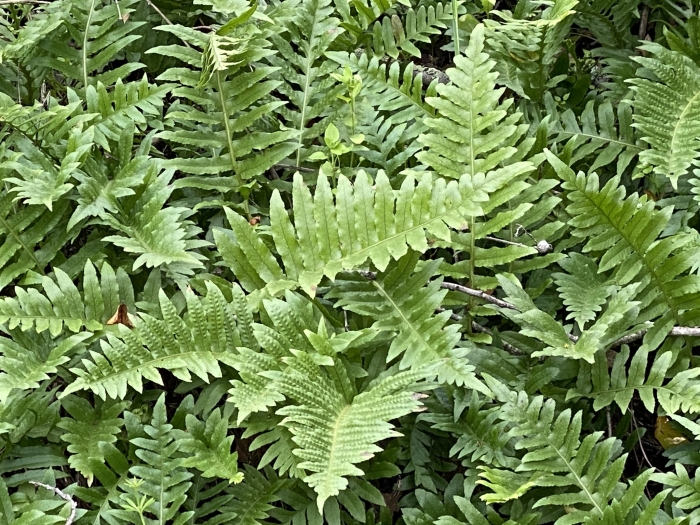California Polypody
(Polypodium californicum)
California Polypody (Polypodium californicum)
/
/

etw
CC BY 4.0
Image By:
etw
Recorded By:
Copyright:
CC BY 4.0
Copyright Notice:
Photo by: etw | License Type: CC BY 4.0 | License URL: http://creativecommons.org/licenses/by/4.0/ | Rights Holder: etw | Publisher: iNaturalist | Date Created: 2020-03-24T15:43:44-07:00 |


















































Estimated Native Range
Summary
Polypodium californicum, commonly known as California polypody, is a perennial fern native to the coastal woodlands and rocky slopes of California and Baja California. It typically grows in shaded or semi-shaded areas, often found in the understory of coastal scrub and woodlands, where it benefits from the moist and well-drained soil conditions. This fern has a scaly rhizome from which fronds emerge, reaching up to 12 inches in length. Each frond is divided into numerous dull-pointed, lance-shaped segments that may vary in texture from thin to somewhat fleshy, with lightly serrated edges. The fronds are a rich green color and can provide a lush appearance in the garden.
California polypody is appreciated for its adaptability to shade and its ability to thrive with minimal care, making it an excellent choice for ground cover in shaded gardens or as an understory plant in woodland settings. It is drought-tolerant once established, requiring low to medium amounts of water, and prefers soils with medium drainage. While it can tolerate dry periods, it looks best with occasional watering during prolonged droughts. It is also useful for erosion control on slopes. In cultivation, it is important to mimic its natural habitat by providing part shade to full shade and avoiding overly wet or waterlogged conditions.CC BY-SA 4.0
California polypody is appreciated for its adaptability to shade and its ability to thrive with minimal care, making it an excellent choice for ground cover in shaded gardens or as an understory plant in woodland settings. It is drought-tolerant once established, requiring low to medium amounts of water, and prefers soils with medium drainage. While it can tolerate dry periods, it looks best with occasional watering during prolonged droughts. It is also useful for erosion control on slopes. In cultivation, it is important to mimic its natural habitat by providing part shade to full shade and avoiding overly wet or waterlogged conditions.CC BY-SA 4.0
Plant Description
- Plant Type: Fern
- Height: 0.5-2 feet
- Width: 0.3-0.7 feet
- Growth Rate: Moderate
- Flower Color: N/A
- Flowering Season: Non-Flowering
- Leaf Retention: Evergreen
Growth Requirements
- Sun: Part Shade, Full Shade
- Water: Low, Medium
- Drainage: Medium
Common Uses
Border Plant, Deer Resistant, Drought Tolerant, Groundcover, Low Maintenance, Potted Plant
Natural Habitat
Coastal woodlands and rocky slopes
Other Names
Common Names: Kalifornisk Stensöta
Scientific Names: Polypodium californicum , Polypodium vulgare var. kaulfussii , Polypodium californicum var. californicum , Polypodium californicum var. kaulfussii , Polypodium californicum f. branscombii , Polypodium californicum f. parsonsiae , Polypodium vulgare subsp. californicum , Goniophlebium californicum , Goniophlebium cambricum var. kaulfusii , Marginaria californica
GBIF Accepted Name: Polypodium californicum Kaulf.